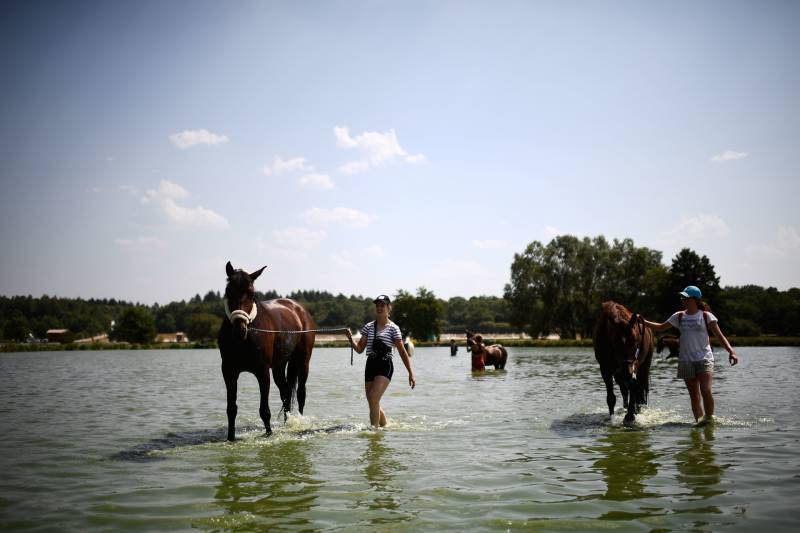By 2070, the world’s habitable climate zone will shift so much that billions of people will be pushed past human comfort levels.
In Just 50 Years, Many Populated Parts of the World Could be Too Hot for Humans

A new study published Monday in the Proceedings of the National Academy of Sciences shows a “surprisingly narrow” human climate niche—between 52 degrees Fahrenheit to 59 degrees Fahrenheit. And it will shift geographically more in the next 50 years than any time during the past 6,000 years. As a result, up to 3 billion people are “likely to live under climate conditions that are warmer than conditions deemed suitable for human life to flourish,” the international team of researchers wrote.
Los Angeles and Paris will bake in fiery desert temperatures, and the world’s most populous cities in Asia and Africa will have deadly heat waves every year.
“It looks unlivable for many,” said co-author Tim Lenton, director of the Global Systems Institute at the University of Exeter. “Where we are headed is a place we don’t want to go.”
Some cities in North America and Europe that are now in the sweet spot of the human climate zone, with mean annual temperatures from 64 degrees and 68 degrees Fahrenheit, will be as warm as the North African coast by late in the century, Lenton said.
“That’s quite a climate shock. We’re going back to temperatures that we haven’t seen for 5 million years, territory that predates the divergence of humans from apes,” he said.
Compounding the climate problem for humans is that the greatest population growth is expected exactly in those zones most affected by human-caused warming. If the inhabitants do not migrate to more livable areas, the researchers projected, one-third of the global population will experience a mean annual temperature warmer than 84 degrees Fahrenheit—an average currently found only on 0.8 percent of the Earth’s land surface, mostly concentrated in the Sahara.
Land areas are warming faster than the oceans, which mean “human-experienced temperatures are projected to rise by about 13 degrees Fahrenheit, more than twice the mean global temperature rise,” said co-author Marten Scheffer, with Wageningen University and Research. The poorest, most densely populated parts of the world, with the lowest adaptive capacity, are potentially the most affected, he added.
The buildup of heat and population could make the human climate bubble burst.
“When you talk about the most extreme temperature end, put simply, one can adapt by having good air conditioning and importing your food. That is an unlikely option for the poorest portion of humanity who happen to be the ones most exposed to extreme conditions,” he said. Humans can survive and live under quite extreme conditions, but the “vast majority has always been concentrated in the places corresponding to conditions that we defined as the climate niche,” he added.
Penn State climate scientist Michael Mann, who was not involved in the research, said, “The study further reinforces an emerging body of research that suggests that it is within our ability, given a very worst case scenario, to make this planet largely uninhabitable to us and other life forms. The good news is that it doesn’t appear we’re headed on that trajectory now, given the progress already being made world-wide in transitioning away from fossil fuels.”
“But,” he added, ‘habitability of the planet’ is a very low bar indeed.”
Massive Migrations and Huge Adaptations
Scheffer said the study tallied population densities based on mean annual temperatures—how many people lived in places where that average reading was 50 degrees, 70 degrees or 90 degrees Fahrenheit. The researchers then identified the temperature niche that has attracted the most people going back 6,000 years. Climate and populations changed, but the bulk of the people were always concentrated under the same conditions.

“Next we looked at the projected climate change using existing model predictions and asked: ‘Suppose that people would remain in the same climate preference as they have over the past 6,000 years, where would they have to be distributed over the globe in 50 years from now?'” Scheffer said.
The projections suggested that the shifting human climate niche would elicit both heroic adaptation measures, as well as massive migrations of people to more suitable climate regions.
“Humanity has responded quite markedly to climate changes in the past. However, none of those in the past 5,000 years have been as strong as the one we are likely facing over the coming 50 years,” he said.
Washington State University evolutionary anthropologist Tim Kohler, who studies how earlier societies adapted to climate change, said he was a little surprised at the relative narrowness of the climate niche.
“We archaeologists like to lecture about how our vaunted technology (clothes, fire, tools, boats…) and highly cooperative social organization have made it possible for us to colonize all habitats on Earth during the last 50,000 years or so,” Kohler said in an email. “That is still true of course, but what we show here is that despite the ability to live in many environments, we are densest within a small subset of those.”
He added that their choice to begin their comparisons 6,000 years ago, a relatively warm time within the Holocene, was “a very conservative choice from the perspective of the finding that the coming warming will be unprecedented.”
Lenton said he hopes the paper will resonate as a “humanized” way to see climate change, and he made comparisons to humanity’s response to the coronavirus pandemic. The massive impacts projected by the new paper will have an immense financial cost. The findings suggest that swallowing the financial pill now to pay for adaptation and planned migration would be less bitter than waiting and responding to events as they unfold.
In response to the pandemic, societies have been recalculating the cost-benefit equation, but for climate change, that reckoning has been on the back burner for too long, he said.
“By casting it in different terms, maybe we can trigger a much-needed change in our way of thinking,” he said. “Stepping out of making an economic judgment and starting to make a human judgment would be a powerful step to take.”
InsideClimate News is a nonprofit, independent news organization that covers climate, energy and the environment. Sign up for the ICN newsletter here.
